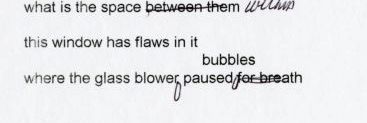The Poem's Gaps
Visually, you will note that nearly every line in the poem contains a gap. Other examples of poems that incorporate gaps within the line are Elizabeth Bishop's "O Breath" from Cold Spring, James Dickey's "The Sheep Child" from Poems 1957-1967, and Robert Duncan's "The Torso (Passages 18)" from Bending the Bow. In many cases, splitting a line creates a call and response where the second half of the line responds to the first. The subtle revision pictured below illustrates how the gaps impact the work.
From: 9/10/2002 draft |
 |
To: 9/17/2002 draft |
 |
The Revision's Visual Impact
The gap along with the deletion of "for breath" places the word "paused" on an island. It stands apart from the rest of the phrase.
The Revision's Grammatical Impact
The gap breaks up the phrase and image. The fragment "Where the glass blower" requires a verb to complete the phrase. By suspending the reader's grammatical expectation, a measure of emphasis is placed on the verb. Examining the phrase's ending a bit further, one might also note that the phrase's action, "paused," is marked by the lack of action.
The Revision's Musical Impact
The pause signaled by the gap accentuates the reader's (or listener's) desire to have the grammatical expectation fulfilled. It's what one might call "a dramatic pause." Think, for example, of Franklin Roosevelt delivering his famous line "the only thing we have to fear is [pause] fear itself."